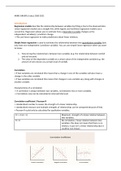Overig
ARMS Grasple aantekeningen + SPSS output voor het SPSS-tentamen
Alle theorie die behandeld is in SPSS voor ARMS! Hierin staan ook tabellen van SPSS en alle stappen die je moet uitvoeren voor elke analyse. Ook heb ik extra informatie uit de lessen en van het internet toegevoegd om het duidelijker te maken. Indien je dit document leest hoef je de Grasple less...
[Meer zien]




